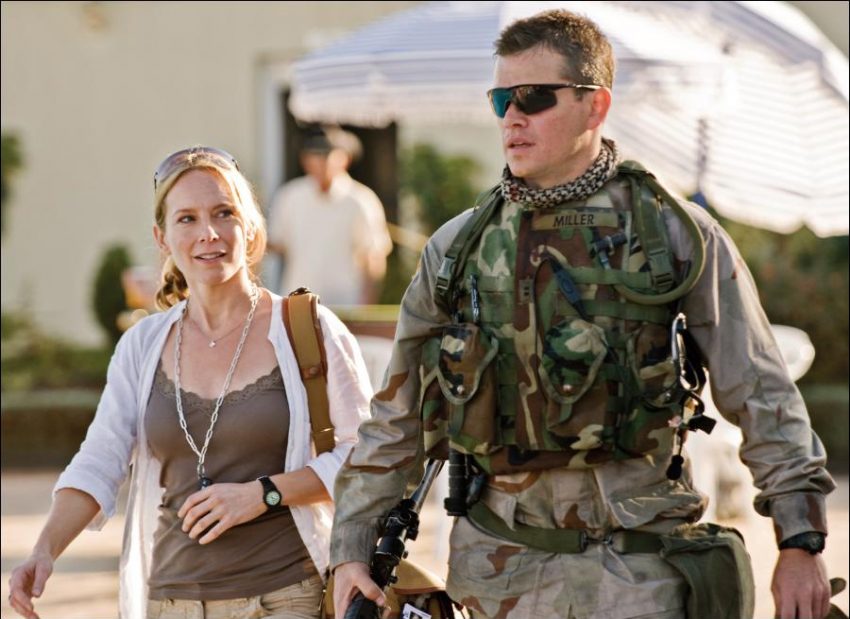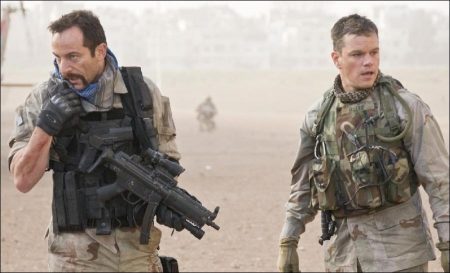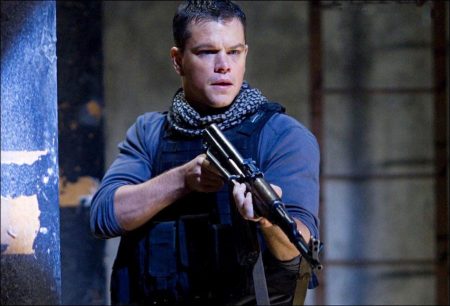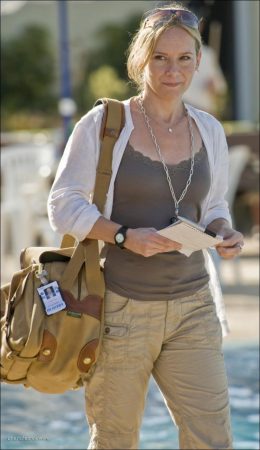Taglines: He’s done following orders.
During the U.S.-led occupation of Baghdad in 2003, Chief Warrant Officer Roy Miller (Damon) and his team of Army inspectors were dispatched to find weapons of mass destruction believed to be stockpiled in the Iraqi desert. Rocketing from one booby-trapped site to the next, the men search for chemical agents but stumble instead upon an elaborate cover-up that inverts the purpose of their mission.
Spun by operatives with intersecting agendas, Miller must hunt through covert and faulty intelligence hidden on foreign soil for answers that will either clear a rogue regime or escalate a war in an unstable region. And at this blistering time and in this combustible place, he will find the most elusive weapon of all is the truth.
Green Zone is a 2010 war thriller film directed by Paul Greengrass. The storyline was conceived from a screenplay written by Brian Helgeland, based on a 2006 non-fiction book Imperial Life in the Emerald City by journalist Rajiv Chandrasekaran. The book documented life within the Green Zone in Baghdad during the 2003 invasion of Iraq.
Green Zone premiered at the Yubari International Fantastic Film Festival in Japan on February 26, 2010, and was released in Australia, Russia, Kazakhstan, Malaysia and Singapore on March 11, 2010, followed by a further 10 countries the next day, among them the United States, United Kingdom and Canada. The film generally received mixed critical reviews and was a box office flop, as it cost $100 million to produce plus $40 million in marketing, while the global theatrical runs only gave $94,882,549 in gross revenue.
Mission Begins
As he contemplated wading into the world of Green Zone, director / producer Paul Greengrass knew he wanted his next film to grab people by their shirts with a high-stakes thriller, drenched in the authentic details of a war zone. “This is not a movie about the war in placecountry-regionIraq,” the filmmaker emphasizes. “It’s a thriller set in placecountry-regionIraq, and that’s a very different proposition. In my experience, thrillers are at their best when they’re in extreme environments where the moral challenges are acute.”
Over the course of the past decade, Greengrass has become renowned for his pulse-pounding action-thrillers. The last two Bourne films he helmed achieved a rare feat: the ability to impress critics and worldwide audiences alike. But the filmmaker is equally well known for his hard-hitting and meticulously researched dramatic movies.
With United 93, the story of the brave passengers and crew who rallied against terrorist hijackers on September 11, Greengrass not only honoured the memories of the heroes lost that day, he created a powerful dramatic thriller that invested audiences in their lives. Critical nods included an Academy Award nomination for Best Director in 2007, a Best Original Screenplay nomination from the Writers Guild of America and BAFTA’s David Lean Award for Direction. As well, his 2002 film, Bloody Sunday, which depicts the brutal murders of 13 civil rights marchers in Northern Ireland, won top prizes at the Berlin and Sundance film festivals.
Many moviegoers may not be aware that Greengrass began his career covering global conflict for Britain’s ITV. During that 10-year span, he travelled to war-torn countries and reported upon powerful stories. After shifting his focus to fictional dramatic fare, he still found himself drawn to creating films that explored timely social events. By blending a documentarian’s rigorous discipline with a dramatic filmmaker’s sense of structure and plot, he heightened the impact of his projects. Explains producer Lloyd Levin: “Paul has a very keen sense of how to bring each beat of a story to life. He creates the most dramatic version of reality he can.”
In between his two blockbuster thrillers starring Matt Damon as amnesiac super-agent Jason Bourne, Greengrass wrote, directed and produced United 93. A deeply rewarding experience for the team, the heart-stopping United 93 left Greengrass and fellow producers Tim Bevan, Eric Fellner and Lloyd Levin eager to develop another project together. “This time, we decided to make a bigger film, but still set against a real backdrop,” notes Bevan. “That was our starting point.”
The initial idea that Greengrass discussed with screenwriter Brian Helgeland was to develop a thriller about the failed hunt for weapons of mass destruction (WMDs). Along the way, they sought the active collaboration of many participants in the Iraq drama, including key figures in the WMD hunt, two dozen US combat vets who served in Iraq, a half-dozen ranking former CIA officers with first-hand experience and an elite CIA paramilitary team leader who captured several of Iraq’s “Most Wanted.”
Inspiration would also come from former Washington Post Baghdad bureau chief Rajiv Chandrasekaran’s best-selling non-fiction book “Imperial Life in the Emerald City: Inside Iraq’s Green Zone.” Chandrasekaran, who reported first hand from Baghdad on the weapons-inspection process, won the Overseas Press Club book award, the Ron Ridenhour Prize and Britain’s Samuel Johnson Prize, and became a finalist for the National Book Awards. His much-acclaimed book served as a window into the world of the Green Zone.
Levin sums up their motivation: “Paul and Brian wanted to incorporate the world of the Green Zone and the hunt for weapons of mass destruction into a thriller. We knew this source material was just what we needed.”
As the project developed, Greengrass understood it would be the perfect blend for his and his often-star’s sensibilities. He offers: “When Matt and I finished The Bourne Ultimatum, we sat down to discuss our next project. It was obvious that the most dangerous place in the whole of the world at that point was Baghdad. And it was just as obvious to us that the challenge was whether we could make an authentic and believable thriller there.
“Thrillers are in a language audiences understand,” Greengrass says. “People come to the cinema to be taken places that only cinema can take them. They can be fantastical places of the imagination, or the compelling real-life environments that we see on television news. Cinema can take you there in a way that the news simply cannot.
“For both Matt and me, our creative mission was `Can we create a film that’s every bit as compelling, filled with action, exciting, mysterious, and a privileged inside view to a secret world as the Bourne films, but can we do it in that extreme environment of downtown Baghdad in those desperate weeks immediately after the invasion?’ I’m confident the audiences will say, `Yes, they can.’”
With Green Zone, Greengrass worked with Helgeland to weave a dramatic story set against a time period of historical events. Their mission: Bring audiences across the exotic deserts of Iraq, with a view from the front seat of Roy Miller’s Humvee. That landscape also includes sequestered chambers of the Republican Palace, where the US-led provisional government aimed to put the country back together again, as well as the shadowy streets where operatives hunted down the men deemed Iraq’s “Most Wanted.”
Helgeland imagined a screenplay in which a WMD hunter comes to Iraq with one objective: to find weapons and save lives. Loyal to his mission and team, Miller sets out to find those responsible for those creating and potentially detonating WMDs. His end game? To bring them in and guarantee that justice is served. Miller is told that a source with the code name of Magellan met with US officials prior to the war and guaranteed that weapons actually exist, and Hussein was ready to deploy them on his own people and any usurpers. What Miller is finding, however, does not add up.
The screenwriter developed a story in which his protagonist begins to question the intel behind this list of potential weapons locations: the warrant officer finds that site after site yields nothing. Miller receives no answers through official channels, but off-the-record encounters with a veteran CIA operative, an Iraqi civilian and a journalist point him toward the elusive source Magellan and lead him into conflict with a civilian Defence Department intelligence head, as well as a Special Forces officer and a shadowy group of formerly influential Iraqis with conflicting agendas.
Recruiting the Players
Not long after they wrapped principal photography on their second collaboration, Matt Damon agreed to a third project with the man who directed him in The Bourne Supremacy and The Bourne Ultimatum. “Working with Paul is an invigorating process because he insists on capturing something real for the camera,” commends Damon. “It’s no surprise when you look at his other work. Not a moment of Bloody Sunday is contrived or promotes a personal agenda. United 93 practically vibrates with tension as its characters recognize the truth of their situation. Paul wants the audience to feel that truth and tension along with the characters.”
The opportunity to partner again with his long-time friend wasn’t Damon’s only motivation in signing on to Green Zone. He explains: “Besides working with Paul, who I admire and whose movies I really like, the big thing for me was the chance to work with a bunch of veterans who had just come back from Iraq and Afghanistan. They were the ones who really made our cast. They helped create an environment that felt very authentic. To be around people who are alert and who have been in those situations before is invaluable as an actor.”
As Chief Warrant Officer Roy Miller, Damon portrays a career soldier who served in the 1990 Gulf War and is now doing duty in a very different Iraq. He returns to the region in 2003 to lead a gung ho team of WMD hunters known as MET D (Mobile Exploitation Team Delta). His soldiers have one objective: evacuate a long list of reputed WMD sites.
Much like Jason Bourne, Roy Miller wants only to find out the truth in his precarious situation. Damon elaborates on this character’s motivations: “Miller becomes obsessed with figuring out what’s going on and getting to the bottom of all this. He gets himself reassigned to work for the station chief for the CIA in Baghdad and starts working with him to try and figure out where the weapons are…if they exist at all.”
Greengrass adds: “Miller is a man of action who has had this frustration that builds and builds at not finding the weapons. Then suddenly somebody gives him the opportunity to do something. And he takes it, because he wants to get something done.”
The filmmaker was happy the actor he’d almost run down with subway cars in the London’s Waterloo Station and sent freewheeling through rooftop windows in the Medina area of Tangier was willing to trust him for their third time together.
“Matt drives this movie with a great performance,” notes the director. “This is the kind of role people want to see him in. He’s one of the world’s great physical actors. If you put Matt in a big action-thriller, he commands attention because you know he’s going to go to exciting places-to-be absolutely determined to get to the truth and exhibit courage. He’s going to be running and jumping and chasing and fighting and doing all those things that you want to see Matt Damon do. But he does them with class and integrity and also tells a great story.”
Cast as Miller’s nemesis, Defence Intelligence agent Clark Poundstone, was Greg Kinnear. The actor quickly adapted to Greengrass’ unique shooting style of allowing his actors situational improv, and Kinnear’s co-star was a big help in achieving that skill. “Matt advised me on how all this would work,” Kinnear says. “It’s a big change from most traditional movie sets. As you adjust, you start to realize that it’s exhilarating and very unpredictable.”
The Defence Intelligence agent has ostensibly come to Iraq to repair the damage that’s been done to it; he will achieve this goal by any means necessary. “Poundstone believes this place can be put back together very quickly, and that it’s all about the end game, not the means of getting there,” reveals Kinnear. “This story has multiple points of view, and with Paul’s way of working, everybody’s argument is given space.”
Irish native Brendan Gleeson was asked by the filmmakers to portray Martin Brown, the CIA station chief to whom Roy Miller turns when he believes there is no one else he can trust. Of the character, Greengrass laughs, “From my point of view, it’s good to have a CIA character that’s a good guy, after the Bourne movies.”
The journalist who finds herself unknowingly serving as Poundstone’s mouthpiece is prominent Wall Street Journal writer Lawrie Dayne. Chosen to play the newswoman was performer Amy Ryan, introduced to many audiences in her much awarded breakout role in Gone Baby Gone. By the spring of 2003, Dayne has become an expert on the subject of chemical warfare and is embedded in the Green Zone, where she is unwittingly being fed stories by the duplicitous Poundstone.
Green Zone (2010)
Directed by Paul Greengrass
Starring: Matt Damon, Amy Ryan, Greg Kinnear, Khalid Abdalla, Eugene Cherry, Alexander Drum, Nathan Lewis, Nicoye Banks, Sean Huze, Michael J. Dwyer, Brian Siefkes, Abdul Henderson
Screenplay by: Brian Helgeland
Production Design by: Dominic Watkins
Cinematography by: Barry Ackroyd
Film Editing by: Christopher Rouse
Costume Design by: Sammy Sheldon
Set Decoration by: Lee Sandales
Art Direction by: Juan Pedro De Gaspar
Music by: John Powell
MPAA Rating: R for violence and language.
Distributed by: Universal Pictures
Release Date: March 12, 2010





